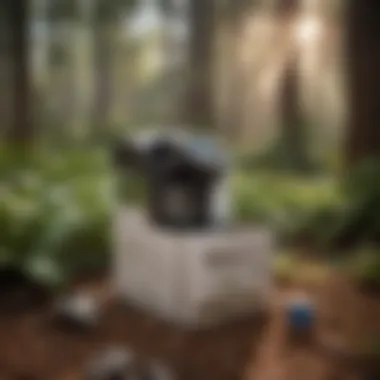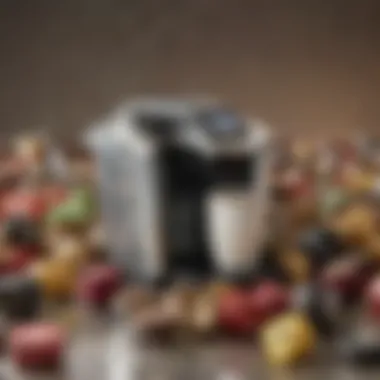Keurig Recycling Boxes: A Comprehensive Guide


Intro
As coffee enthusiasts, we often prioritize the flavors and aromas of our favorite brews, but it is essential to also consider the impacts of our coffee consumption on the environment. One little-known aspect of modern coffee practices is the single-serve coffee pod. While the convenience of pod-based brewing systems like Keurig is appealing, these pods pose significant environmental challenges.
The rise of the Keurig system brought us quick and easy coffee but also contributes to growing waste problems. To tackle this issue, Keurig has introduced recycling initiatives, letting users participate in efforts to reduce waste. In this article, we will explore the Keurig recycling boxes, their importance in sustainable coffee consumption, the obstacles posed by coffee pods, and the ways consumers can engage with recycling programs.
Understanding these elements helps us make informed decisions about our coffee habits and how they affect our planet. In the following sections, we will present the challenges related to coffee pod waste, Keurig's recycling initiatives, and practical steps for users to play a part in these sustainability efforts. Let’s delve into Keurig recycling boxes and their role in promoting a more responsible approach to coffee consumption.
Intro to Keurig Recycling Boxes
The increase in popularity of single-serve coffee makers like Keurig has raised significant questions about sustainability. As more people enjoy the convenience of brewing coffee at home, the environmental impact of coffee pod waste cannot be ignored. This article delves into the concept of Keurig recycling boxes, examining their role in mitigating waste and promoting responsible consumption among coffee enthusiasts.
What Are Keurig Recycling Boxes?
Keurig recycling boxes are specialized containers designed for the collection and proper disposal of used coffee pods. These boxes enable users to gather their empty pods conveniently and return them for recycling. The design of these boxes promotes ease of use, encouraging individuals to recycle in a structured manner rather than discarding pods in regular trash.
By using these boxes, consumers can participate in a system that supports recycling efforts. Keurig has implemented these recycling programs to address concerns about waste in the coffee sector and to reduce their ecological footprint. This initiative is a step toward creating a circular economy within the coffee industry, where products are reused and reprocessed rather than contributing to landfill overflow.
The Need for Recycling in the Coffee Industry
The coffee industry is under pressure to improve its sustainability initiatives. Single-use coffee pods, popularized by machines like Keurig, have come under scrutiny due to their contribution to plastic waste. In fact, millions of pods end up in landfills each year, where they can take decades to decompose.
The need for recycling in this sector is critical for several reasons:
- Environmental Impact: Non-recyclable pods add to our growing waste problem, which can harm wildlife and pollute ecosystems.
- Consumer Awareness: As awareness of environmental issues increases, consumers are seeking more sustainable products and practices. They desire brands that prioritize environmental responsibility.
- Regulatory Pressure: Governments and organizations are pushing for greener practices across all industries, including coffee production.
By embracing recycling initiatives such as those provided by Keurig, both the company and its consumers can contribute to a more sustainable future.
"Implementation of recycling systems in the coffee industry is crucial for minimizing environmental impact and building a sustainable consumption model."
As we explore the deeper implications of these recycling boxes and their effectiveness, it becomes clear that the responsibility for sustainability lies with both manufacturers and consumers. Understanding the available recycling options is essential for making informed choices about coffee consumption.
Understanding Single-Serve Coffee Pods
Single-serve coffee pods have transformed the way people enjoy their daily brew. This section is crucial for understanding the broader implications of Keurig's recycling initiatives. Single-serve pods offer convenience, allowing consumers to prepare a fresh cup of coffee quickly. However, this convenience comes with environmental costs that cannot be overlooked. By examining the composition and disposability of these pods, consumers gain insight into their role in contributing to waste. Through this understanding, readers will be better positioned to make informed decisions about their coffee consumption habits.
Composition of Coffee Pods
Keurig coffee pods, also known as K-Cups, contain a blend of coffee grounds, filters, and packaging. Typically, the outer material is made from a type of plastic called #5 polypropylene, which is considered more recyclable than many other plastics. Inside the pod, coffee grounds are sealed within a filter made of paper, allowing for the brewing process to take place while preventing residue from entering the cup. Not all types of coffee pods can be recycled, mainly due to the mixture of materials used.
However, Keurig has made strides to improve the recyclability of their products. In 2020, the company announced all K-Cups would be made recyclable. This change is significant because education on proper disposal practices becomes essential. Many consumers might not realize that the still wet grounds should be removed from the pods before recycling. This understanding leads to more effective recycling outcomes and illustrates the importance of proper disposal practices.
Environmental Impact of Coffee Pod Waste
The environmental footprint of single-serve coffee pod waste is substantial. Each year, billions of coffee pods are consumed, many of which end up in landfills. Plastics take hundreds of years to decompose, and the sheer volume exacerbates the already critical problem of plastic pollution. When coffee pods are disposed of improperly, they contribute to the growing issue of waste not just environmentally but also socially, as communities bear the burden of waste management.
However, there is a shift towards a better future. The increased availability of Keurig recycling boxes allows consumers to participate actively in reducing their environmental impact. By taking advantage of these initiatives, coffee drinkers can play a role in minimizing waste generation. Each pod recycled is a step in the right direction toward achieving a more sustainable coffee culture.


"Recycling is not just about disposing of waste but transforming how we think about consumption."
Understanding the composition and environmental impact of coffee pods is essential not only for coffee lovers but also for anyone interested in sustainable practices. By making conscious choices, consumers contribute to the effectiveness of recycling programs.
Keurig's Commitment to Sustainability
Keurig has positioned itself as a notable player in the coffee industry, especially regarding sustainability. The commitment to reducing environmental impact is crucial in the current landscape of consumer awareness and responsibility. With the increasing emphasis on eco-friendly practices, it's essential to recognize how Keurig addresses the challenges associated with single-serve coffee consumption. This commitment reflects not just corporate responsibility, but also a wider role in encouraging consumers to engage in sustainable practices.
By focusing on recycling, Keurig seeks to mitigate the effects of waste generated by single-serve pods. Understanding this commitment can help consumers make informed choices about their coffee habits, promoting an environmentally conscious culture. It also encourages a discussion about how businesses can balance profit with their ecological responsibilities.
Overview of Keurig's Recycling Initiatives
Keurig has implemented several initiatives aimed at improving recycling rates of its coffee pods. One pivotal part of this strategy is the introduction of specially designed recycling boxes. These boxes serve as a practical solution for consumers who might otherwise discard pods improperly. They simplify the recycling process, making it more accessible and straightforward.
Moreover, Keurig has diversified its efforts by providing guidance on how to separate recyclable materials from non-recyclables. This aspect is especially important, as clarity in recycling processes leads to better compliance from users. The initiatives might also include educational campaigns to raise awareness about proper recycling methods and the environmental implications of improper disposal.
Collaboration with Recycling Partners
Collaboration is a key element in Keurig's recycling strategy. The company works closely with established recycling partners to enhance the effectiveness of its initiatives. These partnerships extend the reach of Keurig's programs, enabling collection and processing systems that traditional methods might not achieve.
By joining forces with specialized recycling companies, Keurig ensures that pods are handled properly. This cooperation not only increases recycling rates but also contributes to a circular economy where materials are reused rather than ending up in landfills. This approach signifies a proactive stance toward sustainability, emphasizing that partnerships can yield better results than isolated efforts.
Keurig recognizes that achieving its sustainability goals requires a community effort. By collaborating with partners focused on enhancing recycling systems, the company amplifies the impact of its initiatives, providing consumers with a seamless way to contribute to environmental preservation.
How to Use Keurig Recycling Boxes Effectively
Using Keurig recycling boxes effectively is crucial for anyone aiming to integrate sustainable practices into their coffee consumption. This section will delve into the steps required for optimal usage and highlight the importance of proper recycling behavior. Effective use not only aids in reducing waste but also reinforces personal responsibility in addressing environmental concerns associated with single-serve coffee pods.
Steps to Prepare Pods for Recycling
The preparation of coffee pods for recycling is a straightforward process, yet many overlook its significance. Here are step-by-step actions to ensure proper preparation:
- Collect Used Pods: Begin by gathering all used coffee pods. It is essential to keep them in a designated spot until you are ready to recycle.
- Remove the Lid: Most recycling programs require that the plastic lid of the pod be removed. Carefully peel off the lid to separate it from the pod. This step is important as it ensures that the materials can be correctly processed during recycling.
- Empty the Coffee Grounds: Dispose of the coffee grounds appropriately. You can either compost them if possible or throw them in your general waste bin, depending on your local regulations.
- Rinse the Pod: If feasible, rinse the pod with water to eliminate residue. This can enhance the quality of recycling as it reduces contamination.
- Store for Collection: Once prepared, place the pods into the recycling box. Make sure the box is secure and stored in a convenient location for easy access.
These steps, while simple, require consistency. Consumers should build a habit of preparing pods correctly every time they finish coffee, fostering a more sustainable approach.
Proper Disposal of Non-Recyclable Materials
A significant aspect of using Keurig recycling boxes effectively is the appropriate disposal of non-recyclable materials. Not every component of the single-serve coffee system is recyclable. Understanding how to separate these items helps streamline the recycling process and minimizes contamination. Here are guidelines for managing non-recyclable waste:
- Identify Non-Recyclables: Be aware that certain components, like the metal or non-recyclable plastic components, cannot be processed in most recycling facilities. Knowing what goes where is crucial.
- Use Local Guidelines: Refer to your local recycling program's guidelines. They often specify what is accepted in recycling streams. Many communities have different rules regarding non-recyclable items.
- Disposal Method: For materials that cannot be recycled, dispose of them according to local waste management practices. Placing them in regular trash bins guarantees they do not interfere with recycling efforts.
Proper disposal of non-recyclable materials is as important as recycling itself. It ensures that recycling systems function efficiently without contamination.
Understanding how to use Keurig recycling boxes effectively can greatly impact the sustainability efforts of coffee consumers. By preparing coffee pods properly and ensuring the right disposal of non-recyclable materials, individuals can play a vital role in minimizing waste and promoting environmental responsibility.
Availability and Accessibility of Recycling Boxes
The presence and ease of access to Keurig recycling boxes play a vital role in fostering sustainable practices among coffee drinkers. Recycling initiatives are only effective if users can locate and utilize them conveniently. When recycling boxes are readily available, consumers are more inclined to participate in recycling programs. This accessibility leads to increased recycling rates, contributing to a reduction in environmental waste from single-serve coffee pods.


An effective recycling program must incorporate strong communication channels to inform potential users about where these boxes are located. This can include stores that sell Keurig products, coffee shop partnerships, and designated recycling locations. Additionally, ensuring that the process to recycle is straightforward and clearly communicated boosts participation, which benefits both the environment and brand loyalty.
Understanding the significance of this topic extends beyond individual actions; it reflects a broader commitment by companies like Keurig to promote sustainable behavior in a rapidly consuming society. When coffee consumers notice how accessible a recycling solution is, they may reconsider their coffee consumption habits, embracing the opportunity to contribute positively.
Where to Find Keurig Recycling Boxes
Finding Keurig recycling boxes is integral to making responsible choices. You can start by checking local grocery stores that offer Keurig products. Many retailers, such as Walmart and Target, provide designated areas for returning your used pods. In addition, various specialty coffee shops that sell Keurig machines often have recycling options available for customers.
Another useful resource is the Keurig website itself, which frequently updates information about recycling initiatives and where to obtain recycling boxes. Many local municipalities have also started including Keurig recycling in their waste management programs.
Assistance from Local Recycling Programs
Local recycling programs can provide vital support in enhancing the effectiveness of Keurig recycling boxes. These programs often have established networks and resources focused on proper waste management, so they can guide consumers on the best ways to participate in recycling efforts.
Engaging with local recycling authorities can offer additional information on when and where to access recycling boxes specific to your area. They may also offer educational resources about sustainable practices related to single-cup coffee consumption. Being aware of local initiatives helps consumers stay informed about recycling events and seasonal campaigns aimed at increasing plastic diversion from landfills.
Without participation from consumers, recycling programs face challenges. Greater community engagement nurtures not only recycling efforts but also enhances awareness of broader environmental issues.
Analyzing the Effectiveness of Recycling Programs
Analyzing the effectiveness of recycling programs is essential for understanding their true impact and identifying areas for improvement. These programs, especially those associated with Keurig recycling boxes, play a crucial role in fostering an eco-conscious culture among coffee consumers. Through careful evaluation of these strategies, stakeholders can determine whether recycling initiatives are meeting their goals and effectively reducing waste.
Metrics for Success: Recycling Rates
To measure the success of recycling programs, one key metric is the recycling rate. This rate reflects the percentage of materials that are actually sent for recycling compared to the total amount disposed of. In the context of Keurig recycling boxes, calculating how many coffee pods are returned versus how many are sold creates a clear picture of user engagement.
- Recycling Participation: Tracking consumer participation is critical. Higher participation rates suggest that consumers recognize the importance of recycling and are willing to engage in the effort.
- Material Recovery Amounts: Identifying the volume of material recovered from recycled coffee pods gives insight into the effectiveness of the program. This metric addresses both type and amount of materials that are successfully reprocessed into new products.
- Impact on Landfills: Reduction in the number of pods ending up in landfills demonstrates the program's effectiveness in diverting waste away from these sites, which is vital for sustainability efforts.
Challenges in Growing Recycling Participation
While the importance of recycling is widely acknowledged, several challenges remain in increasing participation in these programs. Factors affecting consumer engagement include:
- Awareness Level: Many consumers may simply be unaware of the existence of Keurig recycling boxes. Continuous outreach and education are necessary to inform users about recycling options available to them.
- Convenience: Recycling often requires extra effort. If it is not easy or straightforward, consumers may opt for disposal instead. It is crucial for Keurig to ensure that the process is as simple as possible.
- Product Design: The design of coffee pods impacts recyclability. If products are not designed with recycling in mind, it becomes difficult for existing programs to process them effectively.
"The goal of any recycling program is not only to facilitate waste disposal but to create a culture where users feel empowered to choose sustainable options."
Addressing these challenges can enhance the effectiveness of recycling programs. By improving awareness, convenience, and product design, there is potential for increased consumer participation and a greater positive environmental impact.
Customer Perspectives on Keurig Recycling Initiatives
Understanding customer experiences and attitudes towards Keurig's recycling initiatives sheds light on the effectiveness and acceptance of these programs. This section delves into how users perceive the convenience, transparency, and overall impact of recycling boxes on their habits and beliefs about sustainability in coffee consumption.
User Experiences with Recycling Boxes
User experiences with the recycling boxes often vary, influenced by aspects such as accessibility and ease of use. Many users appreciate the effort that Keurig has made to provide a systematic way to dispose of their pods responsibly. The recycling boxes are often viewed as a practical solution to a common waste problem. Users find the packaging easily recognizable and simple to understand, which encourages participation.
Some customers have reported challenges, such as the need to prepare used pods properly before placing them in boxes. This preparation can include rinsing out the pods and ensuring that non-recyclable components are disposed of separately. While this step may deter some users, many find it a small inconvenience compared to the benefits of reducing waste in landfills. Furthermore, social media groups and forums, such as those on Reddit, often serve as platforms for sharing tips on best practices in using recycling boxes effectively.
Feedback on Sustainability Efforts


Feedback from customers regarding Keurig's sustainability efforts often highlights a strong desire for more transparency and information. Many users want to know specifically how their recycling contributes to broader environmental goals. They seek clarity on where their recycled materials go and how they are processed. This course of action is critical in building trust and encouraging user engagement with the recycling process.
Moreover, some customers have expressed concerns regarding the overall impact of single-serve coffee pods on the environment. They question whether recycling initiatives truly offset the costs of manufacturing new pods. There is a recognition that while recycling is essential, it operates alongside the need for sustainable product design. Users often call for innovations that reduce the necessity for recycling altogether, such as fully biodegradable or compostable pods.
In summary, customer perspectives on Keurig's recycling initiatives provide essential insights into the effectiveness of these programs. While many users are willing to engage in recycling efforts, their experiences denote the importance of simplicity and transparency in recycling processes. Engaging the community and offering clear guidelines will enhance participation and solidify the commitment to sustainability in the coffee industry.
Implications for Future Recycling Innovations
As society becomes increasingly aware of environmental challenges, the importance of finding effective recycling solutions has never been greater. This section will discuss how innovations in recycling can impact sustainability, particularly in the context of single-serve coffee consumption. The future of recycling must not only handle waste but also encourage responsible consumer behavior and address the limitations of current systems.
Trends in Coffee Consumption and Waste Management
In recent years, coffee consumption following rapid growth in various demographics. More people choose single-serve coffee options, driven by convenience and variety. However, this shift leads to a significant increase in waste generation, particularly from coffee pods. The need to address this challenge is crucial for the coffee industry.
Key Trends
- Increased Consumer Awareness: Coffee drinkers are becoming more conscious of the environmental implications of their choices. They demand sustainable options and hold brands accountable.
- Shift Towards Eco-Friendly Products: Consumers favor brands that use recyclable materials or offer compostable alternatives. These preferences influence product development and packaging choices within the industry.
- Innovative Waste Management Solutions: Companies are exploring diverse ways to manage waste more effectively. Partnerships with recycling facilities and educational campaigns are rising, highlighting the importance of proper disposal practices.
This growing awareness and demand present an opportunity for innovative approaches in recycling. Focused efforts will prove essential in developing solutions that align with both consumer desires and environmental needs.
Potential for New Recycling Technologies
Looking ahead, the potential for new recycling technologies is vast. Existing recycling systems face challenges, primarily due to contamination and the complexity of materials used in coffee pods. Advancements in technology can significantly enhance recycling efficiency and recovery rates.
Possible Innovations Include
- Advanced Material Sorting: Technologies that improve sorting accuracy at recycling facilities can help separate recyclable materials from waste more effectively. This increases the overall efficiency of recycling programs.
- Bio-based and Compostable Materials: Development of coffee pods made from biodegradable materials may offer an alternative to traditional plastic and aluminum pods. These products can decompose naturally in appropriate environments, reducing landfill waste.
- Closed-Loop Recycling Systems: Implementing closed-loop systems would allow for the recovery and reprocessing of coffee pod materials. This approach minimizes waste and encourages a circular economy within the coffee industry.
"Innovation in recycling technologies is vital for addressing waste challenges effectively. Companies must prioritize sustainability in product design to meet consumer expectations."
Considering these implications for future recycling innovations, it is clear that proactive measures will be fundamental in creating a sustainable coffee culture.
Epilogue: Towards a Sustainable Coffee Culture
The commitment to a sustainable coffee culture is crucial for mitigating the negative environmental impact associated with coffee consumption, particularly through single-serve coffee pods. This section highlights the overall significance of shifting consumer practices towards sustainability, with an emphasis on concrete actions individuals can take to make a difference. By understanding the pivotal role of Keurig recycling boxes, consumers can transform their daily coffee rituals into more responsible practices that contribute positively to the planet.
Reassessing Consumer Responsibility
Consumers today have a unique opportunity — or maybe duty — to reassess their consumption habits. The phenomenon of convenience has often overshadowed the responsibility that comes with it. It is essential to recognize that every choice, including the selection of single-serve coffee pods, carries weight.
The environmental ramifications of ignoring sustainability are profound. Coffee pod waste does not decompose easily and contributes to increasing landfill mass. A 2019 study indicated that single-serve coffee pods lead to over 20 billion pods being disposed of each year, many of which are not recyclable.
Education plays a key role in consumer responsibility. Understanding how to utilize recycling boxes, along with processing pods correctly, empowers consumers. Engaging with sustainable practices reflects a commitment to the future.
Call to Action: Engaging in Recycling Practices
Engagement in recycling practices is not just an option. It should be seen as a vital part of responsible coffee consumption. Each user of Keurig products can take significant steps to ensure their habits align with sustainability goals.
Here are some effective ways to engage:
- Utilize Recycling Boxes: Make a habit of collecting used pods and transporting them to the nearest Keurig recycling box.
- Educate Others: Share knowledge about the importance of using these recycling boxes within social circles and online platforms.
- Participate in Local Initiatives: Join local recycling programs that align with your values; collaboration strengthens community efforts.
- Get Involved Online: Participate in discussions on platforms like Reddit or Facebook about sustainable coffee practices. Sharing personal experiences fosters a supportive community.
"Sustainable choices in coffee consumption lead to a larger impact on our environment and future generations."
Engaging in these practices cultivates a culture of sustainability around coffee consumption. By acting responsibly, consumers contribute not just to waste reduction but also to the broader movement towards ecological mindfulness in everyday actions. The time to act is now.















